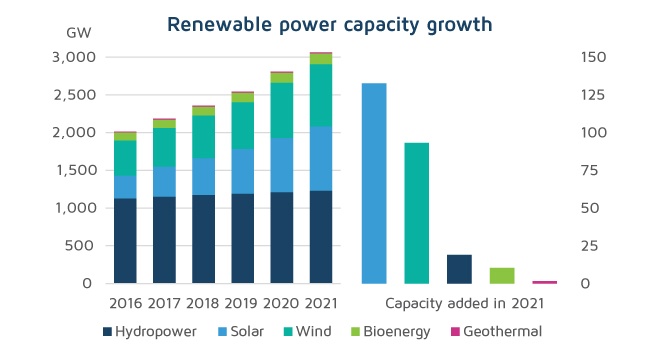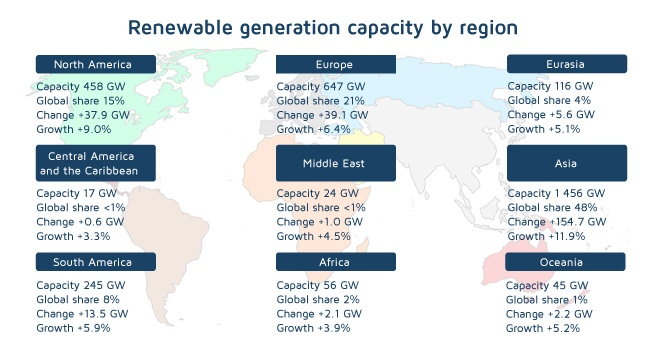The need for climate policy action and change has never before reached such an urgent level. The world faces a race against time to find alternatives now that global warming could reach 1.5 degrees within the next decade – bringing with it a greater possibility of disasters and the intensification of extreme events.
One of the solutions could be investing in renewable energy. The latest data from the International Renewable Energy Agency (IRENA), released in April, shows that renewable energy continued to grow and gain momentum despite global uncertainties. By the end of 2021, global renewable generation capacity increased by 257 GW – a rise of over 9% against 2020.
Solar and wind continue to lead the way in capacity growth. Together, both technologies contributed 88% to the share of all new renewable capacity in 2021. Solar capacity led with a 19% increase (133GW), followed by wind energy with a generating capacity of 133 GW (+13%).

World scenario
Asia has been leading this energy renewal process with almost 60% (154 GW) of the energy generated in the world coming from the continent – mainly from China which grew its renewable energy capacity by 121 GW in 2021. Europe and North America rank next, with 39 GW and 38 GW respectively, with a notably large expansion in the USA (+32 GW).
According to IRENA, in 2050 electricity could become the world’s main energy asset – from the current 20% to almost 50% of all types of consumed energy – and, as a result, gross electricity consumption would more than double. Renewable power will be able to provide the bulk of global power demand (86%).
Should this target be reached, “for every US$1 spent for the energy transition, there would be a payoff of between US$3 and US$7 – or, put in cumulative terms over the period to 2050, a payoff of between US$65 trillion and US$160 trillion”, predicted the agency.
Since 2010, prices of renewable energy have dropped by 73%. Cost declines have been seen in diverse countries ranging from Saudi Arabia and the United Arab Emirates to Brazil and the United States, where wind and solar costs are now approaching between US$ 0.02 cents per kilowatt-hour (kWh), thus becoming rather accessible.

“Money directed to fossil fuel power plants yields unrewarding results, both for the survival of a nation and the planet. Renewable power should become the norm across the globe. We must mobilize the political will to accelerate the 1.5°C pathway,” says IRENA Director-General, Francesco La Camera.
Latin America investments
Beyond the more developed regions of the world such as Asia, Europe, and North America, South America appears to be a promising market for renewable energy investment.
Today, the region already generates 25% of its energy from renewables, largely hydropower and biofuels. Forecasts indicate that by 2050, 93% of the continent’s energy will be supplied by solar and wind energy.
The breakthrough is due to significant investments in the sector. Between 2010 and 2015, Latin America invested over US$120 billion in renewables, which placed several countries in Latin America among the top 10 largest renewable energy markets globally. In 2021, investments on the continent exceeded US$16 billion, accounting for over 6% of the global amount.
Transition to renewable energy would not only clean up the power grid but also boost the economy. A report by the Inter-American Development Bank states that decarbonisation will generate 15 million new jobs overall and an additional 100,000 full-time jobs in the renewable electricity sector by 2030, compared to projections based on current trends.
There is a consensus among experts that the region needs to invest quickly and heavily if it wishes to achieve this reality. Solar and wind are still in their infancy in major countries despite the fact that Brazil, Chile, and Mexico have the world’s highest levels of sunlight, making them ideal locations for solar panel installations while high winds in northern Colombia and southern Argentina could generate sufficient wind power to more than meet the country’s energy demands.
“The renewable energy sector is a powerful engine of growth, job creation, and innovation. We must start by giving access to electricity to the 20 million Latin Americans who still do not have it,” says Alicia Bárcena, Executive Secretary of the Economic Commission for Latin America and the Caribbean (ECLAC).
Brazil on rise
Brazil is a clear example of the changes that need to be made in its energy grid. Experiencing one of the worst water crises of the last century, it has had to activate coal thermoelectric plants since September last year which has caused the price of electricity bills to shoot up for consumers.
According to analysis by the International Energy Agency, the country has the second most expensive energy in the world with only Germany ahead of Brazil according to the survey.
However, the future could be more positive with Brazil ending 2021 leading the generation of solar energy on the South American continent, reaching the historic mark of 14 GW of installed capacity of photovoltaic solar energy according to data from the Brazilian Photovoltaic Solar Energy Association (Absolar).
This number is very impressive as it equates to the level of power that the binational hydroelectric plant of Itaipu – the largest in the country generates. This plant also generates energy for Paraguay.
Since 2020, Brazil has invested heavily in distributed generation projects that involve solar panels on roofs or on land to directly meet the demand of people or businesses and surpassing large plants in terms of capacity.
“We perceive the arrival of a third wave, of ‘conservative’ companies, those that are the great ocean liners. They are coming with strength to solar in Brazil. We also see large corporate customers starting to buy solar energy,” said the President of Absolar, Rodrigo Sauaia.
One of the niches that has increased interest, especially in distributed generation, is the agricultural sector.
“The rural producer also has this more conservative profile, because he already deals with the risk of the climate. We are seeing that solar is starting to become a very intense partner of agribusiness,” explained Sauaia.
The timing is so positive for investment in the country that international companies such as China’s CGN, Norway’s Statkraft, and VRTM, a joint venture between Canadian CPPIB and Votorantim Energia, recently confirmed that their next projects in Brazil should involve the photovoltaic plants.
The Canadian infrastructure company, Brookfield, has made its debut in the country with the acquisition of a giant plant to be completed by 2023 while the French company, Engie, and the Portuguese company, EDP, have expanded their focus on technology which even came into the sights of oil companies such as Shell in 2021.
“Solar has gained strength, it is changing its level and scale. It is a source that is now becoming more interesting for this profile of investors, who are larger, and before that, they looked more at other renewables, more specifically wind energy,” said Director of Clean Energy Latin America consultancy, Camila Ramos.

